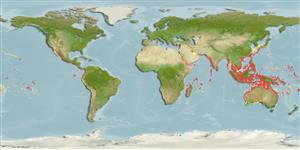Common names from other countries
>
Carangiformes (Jacks) >
Carangidae (Jacks and pompanos) > Scomberoidinae
Etymology: Scomberoides: Greek, skombros = tunny or mackerel, 1623 + Greek, oides = similar to (Ref. 45335).
More on author: Cuvier.
Environment: milieu / climate zone / depth range / distribution range
Ecologia
marinhas; estuarina associadas(os) a recifes; intervalo de profundidade 20 - 50 m (Ref. 28016). Tropical; 26°C - 29°C (Ref. 4959)
Indo-West Pacific: widespread throughout the Indian Ocean from Natal, South Africa northward and from Japan south to Australia and east to Fiji.
Length at first maturity / Tamanho / Peso / Idade
Maturity: Lm 26.0 range ? - ? cm
Max length : 60.0 cm TL macho/indeterminado; (Ref. 3197); common length : 40.0 cm TL macho/indeterminado; (Ref. 5450); peso máx. Publicado: 510.00 g (Ref. 40637)
Espinhos dorsais (total) : 7 - 8; Raios dorsais moles (total) : 19 - 21; Espinhos anais: 3; Raios anais moles: 18 - 20. Dorsally bluish, ventrally silver or white, with 5-8 vertically oblong or oval black spots5-8, the first 4-5 intersect the lateral line, dorsal fin lobe black outer half (Ref. 3197, 90105). Body strongly compressed, oblong and elliptical, dorsal and ventral profiles equally convex. In adults, upper jaw extends to posterior edge of pupil. Soft rays of posterior dorsal and anal fins consist of semi-detached finlets (Ref. 90102).
Adults are found near the surface in coastal waters (Ref. 30573), in small schools. They feed on fishes (Ref. 5213). Dorsal and anal fins may carry toxins (Ref. 12484). Generally marketed fresh, may be dried or salted (Ref. 5284).
Life cycle and mating behavior
Maturities | Reprodução | Spawnings | Egg(s) | Fecundities | Larvas
Paxton, J.R., D.F. Hoese, G.R. Allen and J.E. Hanley, 1989. Pisces. Petromyzontidae to Carangidae. Zoological Catalogue of Australia, Vol. 7. Australian Government Publishing Service, Canberra, 665 p. (Ref. 7300)
Categoria na Lista Vermelha da IUCN (Ref. 130435)
CITES (Ref. 128078)
Not Evaluated
Utilização humana
Pescarias: pouco comercial; peixe desportivo: sim
Ferramentas
Relatórios especiais
Descarregue XML
Fontes da internet
Estimates based on models
Preferred temperature (Ref.
115969): 23.5 - 28.7, mean 27.8 (based on 381 cells).
Phylogenetic diversity index (Ref.
82804): PD
50 = 0.5625 [Uniqueness, from 0.5 = low to 2.0 = high].
Bayesian length-weight: a=0.00851 (0.00668 - 0.01084), b=2.88 (2.81 - 2.95), in cm Total Length, based on LWR estimates for this species (Ref.
93245).
Nível Trófico (Ref.
69278): 4.1 ±0.6 se; based on diet studies.
Resiliência (Ref.
120179): Elevada, tempo mínimo de duplicação da população menor que 15 meses (K=0.98).
Fishing Vulnerability (Ref.
59153): Low vulnerability (24 of 100).
Climate Vulnerability (Ref.
125649): High to very high vulnerability (71 of 100).
